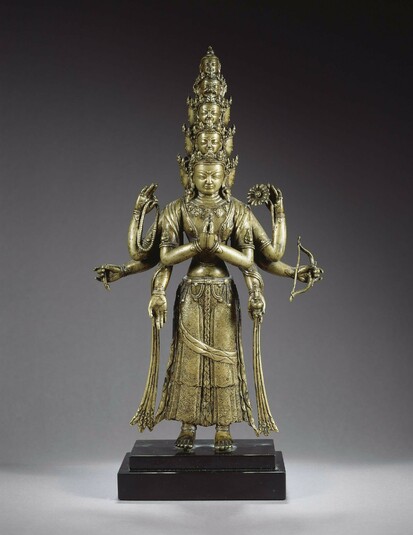
Item: Avalokiteshvara (Bodhisattva & Buddhist Deity) - (11 faces, 8 hands)
| Origin Location | Tibet |
|---|---|
| Date Range | 1500 - 1599 |
| Lineages | Buddhist |
| Material | Metal |
| Collection | Private |
Alternate Names: Lokeshvara Avalokita Lokanata Lokanatha Mahakarunika
Classification: Deity
Appearance: Peaceful
Gender: Male
Avalokiteshvara, Ekadashamukha (Tibetan: chen re zi, shal chu jig. English: the Eleven Faced Lord Gazing on the World): the bodhisattva of compassion. In this form with eleven faces and multiple hands he is understood as a meditational deity with Tantric meditation commitments and ritual practices. Often the eight arms scene especially in sculpture and sometimes in painting are are an abbreviated method of the artist in the depicting of the one thousand arms that this form of Avalokiteshvara typically displays.
Peaceful in appearance, with eleven faces rising upward in groups of three, the 10th is wrathful and the face at the top is that of the buddha Amitabha. Each face has two eyes and a dot between the eyebrows; long black hair flows across the shoulders. With 8 hands the first pair at the heart hold a precious jewel. The three right hands extended to the side are in the mudra of generosity, holding a Dharma wheel and a crystal prayer bead mala. The three on the left hold a water flask, a bow and arrow and a lotus blossom. Each face is adorned with a gold crown, ribbons and earrings. Necklaces, bracelets and precious jewels adorn the body and a scarf is wrapped about the neck. A deerskin is worn across the left shoulder and the lower body is covered in various silk fabrics. With the two legs together he stands atop a lotus flower (base missing).
The bodhisattva Avalokiteshvara is the patron deity of Tibet and appears in a variety of forms both peaceful, wrathful and in large mandalas surrounded by numerous deities. As a universal symbol he embodies the compassion of all buddhas of the ten directions and three times. In the standing form with 11 faces he is closely associated with the famous bhikshuni (nun) of Kashmir, Lakshmi (Tib.: Ani Palmo), who popularized a meditation practice incorporating a 2 day purification and fasting ritual. Lord Atisha, Rinchen Zangpo and others popularized this practice throughout Tibet.
History: At one time the bodhisattva Avalokiteshvara made a promise that should he give rise to thoughts of self benefit may the head break into 10 pieces and the body into 1000. After continuously witnessing the misery of beings in various states of existence, discouraged, he gave rise to thoughts of seeking only his own happiness. At that very instant the head and body shattered. Calling out to Amitabha, the buddha came forth and spoke words of encouragement. Gathering up the 10 pieces of the head Amitabha constructed 10 faces - representing the 10 perfections. Gathering the 1000 pieces of the body he constructed another with 1000 hands each with an eye on the palm - representing the 1000 buddhas of the Golden Eon. Finally he placed a duplicate of his own head at the crown - illuminating the entire threefold universe. This story is found in the apocryphal Tibetan text called the Mani Kabum. In that text it also describes how Tara appears from a tear drop coming from Avalokiteshvara's right eye and the goddess Brikuti appears from a tear drop of the left eye. Both Tara and Brikuti are manifesting, like the other enlightened figures, to assist Avalokiteshvara on the path of benefitting all beings and reaching enlightenemnet. Some modern tellings of the story state that the two goddesses were Green Tara and White Tara.
Jeff Watt 9-99
Inscription
English Transliteration: [No inscriptions]
Collection of WGA
Sculpture: Tsang Province Atelier (Iconography)
Buddhist Deity: Avalokiteshvara (Eleven Faces Religious Context)
Buddhist Deity: Avalokiteshvara (Eleven Faces)
Collection: Dutch Collection
Buddhist Deity: Avalokita (11 Faces) Sculpture Masterworks
Sculpture: Tsang Province Atelier, Tibet
Sculpture: Tsang Atelier Masterworks
Sculpture: Tsang Province Atelier (Bodhisattva/Deity)

